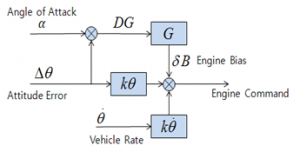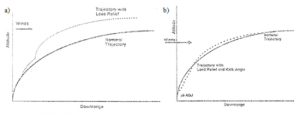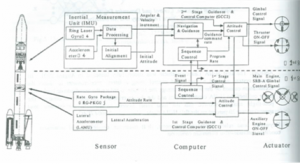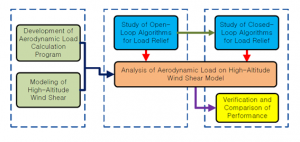RESERARCH
Project Title
(Korean) 고층풍에 의한 발사체 하중 예측 및 하중 경감 유도 알고리듬 개발
(English) Development of a high-altitude wind-shear load prediction method and a load-relief algorithm for launch operations
Objectives
The purpose of this research is to develop a procedure to reduce the in-flight loads caused by the high-altitude wind shear in launch operations. Existing models for high-altitude wind shear will be explored and a procedure to calculate the wind load of a launch vehicle will be developed. Different types of load relief algorithms – both of open-loop and closed-loop form algorithms – will be developed. The performance of the developed algorithms will be analyzed and compared through computer simulations.
Subjects
Aerodynamic loads during atmospheric flight of a launch vehicle is one of critical challenges in launch operations. This research will develop a procedure to reduce the aerodynamic loads in launch operations.
Regional high-altitude-wind shear will be studied and modelled. A program to calculate the aerodynamic load on the launch vehicle will be developed and used to evaluate the load-relief algorithms considered for this study. There are two existing methods to reduce the in-flight loads – an open-loop algorithm and a closed-loop algorithm.
The open-loop algorithm uses the launch-day wind to design the attitude profiles of a launch vehicle. The designed profiles are used for attitude commands, which makes the open-loop algorithm simple to implement. However the method can be vulnerable to the risk of sudden wind profile changes, and is sometimes complemented by statistical methodology to consider the variation in wind shear.
The closed-loop algorithm measures lateral accelerations to calculate aerodynamic angles, which are then fed back to determine the load-relief commands. The method is advantageous in that it can manage the wind variations in real time. To address the sensitivity to the body vibration, the closed-loop form controller should be designed so that the impact of the vibration can be effectively attenuated.
The two algorithms will be verified and compared using numerical simulation. The simulation results will be used to select the best load-relief algorithm to be implemented for launch operations of KSLV-II and its variants.
Related Figures

Autopilot loop of engine bias technique



Aerodynamic Load of Pitch (Left) Engine Deflection Angle (Right)

Flow Chart for the Research
